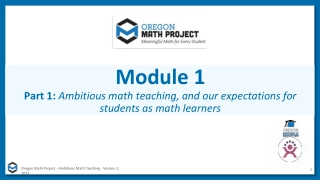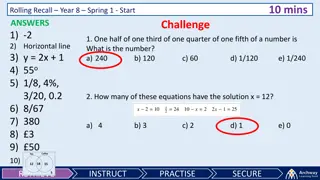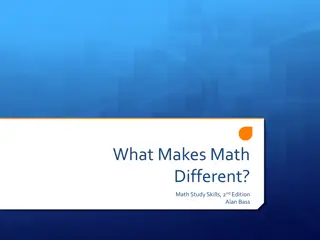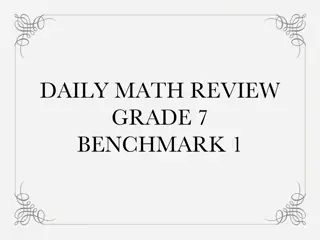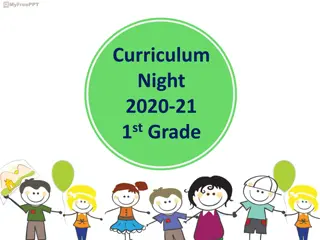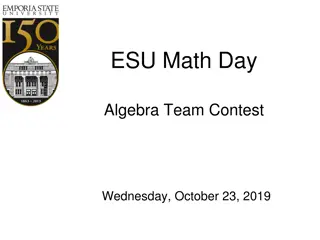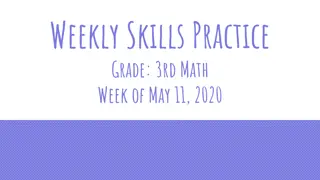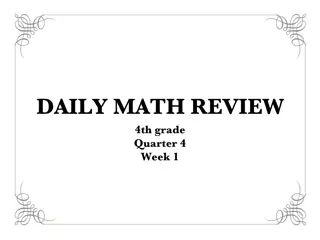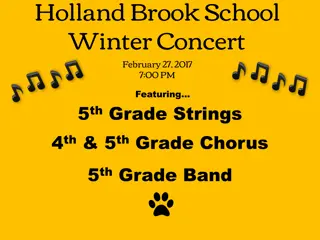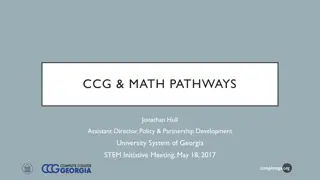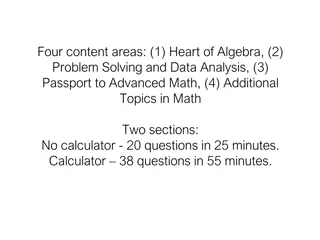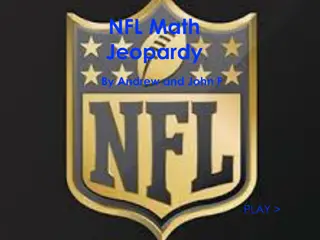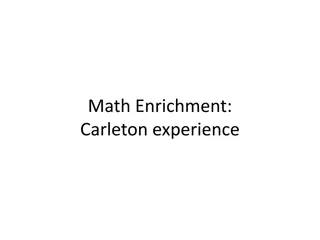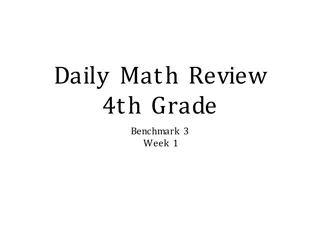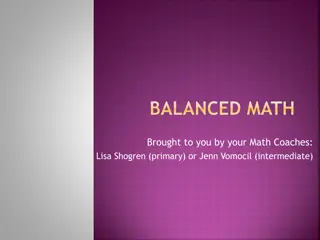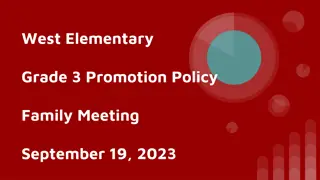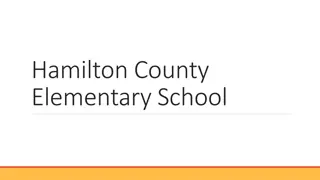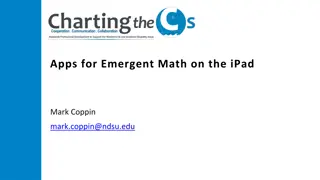Math Concepts for 1st Grade
Explore a variety of math concepts for 1st grade students, including composing and decomposing numbers, generating numbers, using place value, ordering numbers, comparing numbers, and solving word problems. Engage with concrete and pictorial models to enhance understanding and develop foundational math skills.
Download Presentation

Please find below an Image/Link to download the presentation.
The content on the website is provided AS IS for your information and personal use only. It may not be sold, licensed, or shared on other websites without obtaining consent from the author.If you encounter any issues during the download, it is possible that the publisher has removed the file from their server.
You are allowed to download the files provided on this website for personal or commercial use, subject to the condition that they are used lawfully. All files are the property of their respective owners.
The content on the website is provided AS IS for your information and personal use only. It may not be sold, licensed, or shared on other websites without obtaining consent from the author.
E N D
Presentation Transcript
recognize instantly the quantity of structured arrangements.[1.2A] October 2014 Elem Math 1st Grade
use concrete and pictorial models to compose and decompose numbers up to 120 in more than one way as so many hundreds, so many tens, and so many ones.[1.2B] October 2014 Elem Math 1st Grade
use objects, pictures, and expanded and standard forms to represent numbers up to 120.[1.2C] October 2014 Elem Math 1st Grade
generate a number that is greater than or less than a given whole number up to 120.[1.2D] October 2014 Elem Math 1st Grade
use place value to compare whole numbers up to 120 using comparative language.[1.2E] October 2014 Elem Math 1st Grade
order whole numbers up to 120 using place value and open number lines.[1.2F] October 2014 Elem Math 1st Grade
represent the comparison of two numbers to 100 using the symbols >, <, or =.[1.2G] October 2014 Elem Math 1st Grade
use concrete and pictorial models to determine the sum of a multiple of 10 and a one- digit number in problems up to 99.[1.3A] October 2014 Elem Math 1st Grade
use objects and pictorial models to solve word problems involving joining, separating, and comparing sets within 20 and unknowns as any one of the terms in the problem such as 2 + 4 = [ ]; 3 + [ ] = 7; and 5 = [ ] - 3.[1.3B] October 2014 Elem Math 1st Grade
compose 10 with two or more addends with and without concrete objects.[1.3C] October 2014 Elem Math 1st Grade
apply basic fact strategies to add and subtract within 20, including making 10 and decomposing a number leading to a 10.[1.3D] October 2014 Elem Math 1st Grade
explain strategies used to solve addition and subtraction problems up to 20 using spoken words, objects, pictorial models, and number sentences. [1.3E] October 2014 Elem Math 1st Grade
generate and solve problem situations when given a number sentence involving addition or subtraction of numbers within 20.[1.3F] October 2014 Elem Math 1st Grade
identify U.S. coins, including pennies, nickels, dimes, and quarters, by value and describe the relationships among them.[1.4A] October 2014 Elem Math 1st Grade
write a number with the cent symbol to describe the value of a coin.[1.4B] October 2014 Elem Math 1st Grade
use relationships to count by twos, fives, and tens to determine the value of a collection of pennies, nickels, and / or dimes.[1.4C] October 2014 Elem Math 1st Grade
recite numbers forward and backward from any given number between 1 and 120.[1.5A] October 2014 Elem Math 1st Grade
skip count by twos, fives, and tens to determine the total number of objects up to 120 in a set.[1.5B] October 2014 Elem Math 1st Grade
use relationships to determine the number that is 10 more and 10 less than a given number up to 120.[1.5C] October 2014 Elem Math 1st Grade
represent word problems involving addition and subtraction of whole numbers up to 20 using concrete and pictorial models and number sentences.[1.5D] October 2014 Elem Math 1st Grade
understand that the equal sign represents a relationship where expressions on each side of the equal sign represent the same value(s).[1.5E] October 2014 Elem Math 1st Grade
determine the unknown whole number in an addition or subtraction equation when the unknown may be any one of the three or four terms in the equation.[1.5F] October 2014 Elem Math 1st Grade
apply properties of operations to add and subtract two or three numbers.[1.5G] October 2014 Elem Math 1st Grade
classify and sort regular and irregular two-dimensional shapes based on attributes using informal geometric language.[1.6A] October 2014 Elem Math 1st Grade
distinguish between attributes that define a two-dimensional or three-dimensional figure and attributes that do not define the shape.[1.6B] October 2014 Elem Math 1st Grade
create two-dimensional figures, including circles, triangles, rectangles, and squares, as special rectangles, rhombuses, and hexagons.[1.6C] October 2014 Elem Math 1st Grade
identify two-dimensional shapes, including circles, triangles, rectangles, and squares, as special rectangles, rhombuses, and hexagons and describe their attributes using formal geometric language.[1.6D] October 2014 Elem Math 1st Grade
identify three-dimensional solids, including spheres, cones, cylinders, rectangular prisms (including cubes), and triangular prisms, and describe their attributes using formal geometric language.[1.6E] October 2014 Elem Math 1st Grade
compose two-dimensional shapes by joining two, three, or four figures to produce a target shape in more than one way if possible.[1.6F] October 2014 Elem Math 1st Grade
partition two-dimensional figures into two and four fair shares or equal parts and describe the parts using words.[1.6G] October 2014 Elem Math 1st Grade
identify examples and non- examples of halves and fourths.[1.6H] October 2014 Elem Math 1st Grade
use measuring tools to measure the length of objects to reinforce the continuous nature of linear measurement.[1.7A] October 2014 Elem Math 1st Grade
illustrate that the length of an object is the number of same- size units of length that, when laid end-to-end with no gaps or overlaps, reach from one end of the object to the other.[1.7B] October 2014 Elem Math 1st Grade
measure the same object / distance with units of two different lengths and describe how and why the measurements differ.[1.7C] October 2014 Elem Math 1st Grade
describe a length to the nearest whole unit using a number and a unit.[1.7D] October 2014 Elem Math 1st Grade
tell time to the hour and half hour using analog and digital clocks.[1.7E] October 2014 Elem Math 1st Grade
collect, sort, and organize data in up to three categories using models/representations such as tally marks or T-charts. [1.8A] October 2014 Elem Math 1st Grade
use data to create picture and bar-type graphs.[1.8B] October 2014 Elem Math 1st Grade
draw conclusions and generate and answer questions using information from picture and bar-type graphs.[1.8C] October 2014 Elem Math 1st Grade
define money earned as income.[1.9A] October 2014 Elem Math 1st Grade
identify income as a means of obtaining goods and services, oftentimes making choices between wants and needs.[1.9B] October 2014 Elem Math 1st Grade
distinguish between spending and saving.[1.9C] October 2014 Elem Math 1st Grade
consider charitable giving.[1.9D] October 2014 Elem Math 1st Grade


